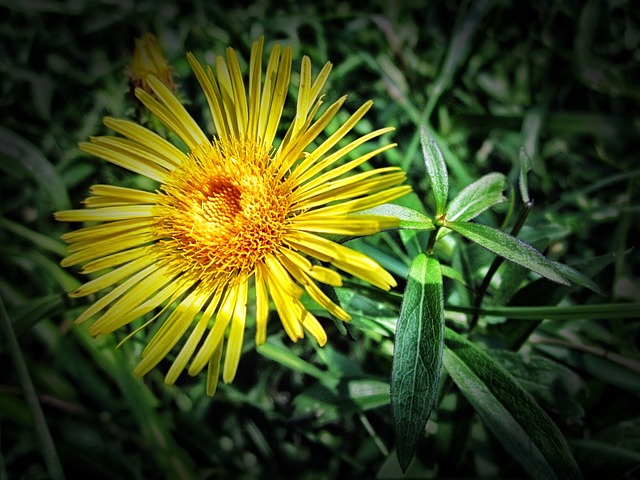
 |  |  |   |   |
 |  |
Irish Fleabane
is a perennial plant with an upright stem up to 80 cm tall. The leaves are arranged alternately on the stem, the veins are loosely tufted. In shape, the leaves are elongated with pointed edges, leathery structure. The leaves are arranged at right angles to the stem.
The flowers of the plant are yellow with a golden reflection, most often single. A fully opened flower reaches up to 35mm in diameter. The plant begins to bloom from June and its flowering continues until August. Fruits - naked seeds.
The above-ground part of the plant is collected during its flowering. Dry in a well-ventilated and shaded place. The roots are dug in autumn and dried at a temperature not exceeding 40-50C. The drug can be stored for 2 years.
The plant contains various valuable chemical elements:
The above-ground part of the plant
Traces of essential oils (<0.06%) - helenine, sesquiterpenoids - gamma lactone, tannins, flavonoids, coumarins, alkaloids.
The underground part of the plant
Essential oil (<2.6%), sesquiterpenoid- alantolactone, isoalantolactone, triterpenoid- friedelin, steroid-beta sitosterol, polysaccharide- inulin (<52%), alkaloids (<0.06%). Polyacetylene compounds - vinyl pentaacetylene.
Plant flowers
Triterpenoids, flavonoids 5-11mg/kg - apigenin, hyperoside, oxycinnamic acids - caffeic acid and chlorogenic acid.
Micro and macro elements such as copper, zinc, lead, silver, molybdenum, barium, strontium, phosphorus, manganese, nickel, titanium, vanadium, chromium, zirconium, lithium, cobalt, yttrium have also been found in the
Irish Fleabane
.
After laboratory tests, carbohydrates, nitrogen compounds, organic acids, triterpene compounds, carotenoids, phenolic compounds, essential oils, sesquiterpene lactones, amino acids were found in all parts of the plant.
Medicinal significance
The plant has been tested in a laboratory and its anti-inflammatory, expectorant and anti-microbial effects have been determined. And as an expectorant plant, it is in no way inferior to its relative Helenium alante.
All parts of this plant are endowed with medicinal properties. The roots, stems, leaves and inflorescences of the plant are used for the treatment of pathologies. Concentrations, decoctions and other medicinal drinks are used for the treatment of various throat diseases and acute respiratory diseases.
The
Irish Fleabane
will also help with angina, spasmophilia, epilepsy and hepatitis. Its effectiveness in the treatment of some skin diseases and STDs has also been established.
Irish Fleabane
preparations have astringent, anti-inflammatory, wound-healing and antiseptic effects. In addition, they work perfectly as expectorants, diuretics and diaphoretics.
Irish Fleabane
are used in folk medicine to prevent various health problems. Its roots and rhizomes are used to treat diseases of the digestive tract, stomach cancer, jaundice, angina pectoris, hyperacid gastritis, furunculosis, scrofulosis, snake bites, syphilis and are used in the postpartum period.
Diarrhea, purulent otitis, angina, toothache, insect bites, women's diseases, ulcers, furunculosis, gonorrhea, epilepsy and scrofulosis are treated with the above-ground part of the plant. It acts as a sedative, anti-bleeding, expectorant, diuretic, diaphoretic and against the development of scurvy.
The leaves of the plant are used to treat angina, hernias, skin rashes, warts, and its leaves are useful as a wound healing agent.
However, most often,
Irish Fleabane
are used to treat:
- Respiratory diseases, including bronchitis and pneumonia;
- Pathologies of the digestive tract;
- Skin diseases - eczema, dermatitis, as well as purulent wounds;
- Rheumatism;
- Metabolic disorders, including diabetes;
- Gynecological problems;
- Tuberculosis;
- Blood vessel problems.